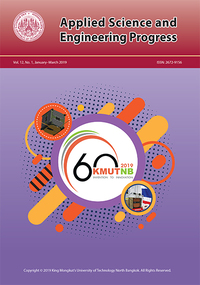Low Temperature Corrosion: Oxidation of Carbon Steel and Stainless Steel in Air
Main Article Content
Abstract
An on-line corrosion monitor based on the principle of produced hydrogen effusion through a pipe wall due to the flow accelerated corrosion has been designed in an operating cycle mode which is complex. Using AISI 1045 and AISI 304 steels as material of probe equipped with this monitor expects to reduce the complexity of this system, the continuous mode. Type, characteristic and thickness of oxides formed on both steel surfaces affect the measurement of the rate of hydrogen production from the corrosion inside the pipe. Formation of oxides on AISI 1045 and AISI 304 at 673 K for 168 and 720 h in air was studied to determine type and thickness of oxides formed on steel surfaces under different exposure times. Oxidation of steels was performed in the heated air inside the furnace. The oxide formed on AISI 1045 surface was magnetite with different sizes of oxide particles because of the different exposure times. The oxide formed on AISI 304 surface was found as iron oxide and chromium oxide for 720 h. The thicknesses of oxides formed on AISI 1045 were 2.92 μm and 6.22 μm for 168 and 720 h, respectively. While the thicknesses of oxides formed on AISI 304 were not determined due to the irregular characteristic of oxide formed. Type and thickness of oxides obtained from this research could be used to predict the hydrogen pressure inside AISI 1045 and AISI 304 probes.
Article Details
References
[2] M. Imran, “Effect of corrosion on heat transfer through boiler tube and estimating overheating,” International Journal of Advanced Mechanical Engineering, vol. 4, pp. 629–638, 2014.
[3] V. Chawla, A. Chawla, D. Puri, S. Prakash, P. G. Gurbuxani, and B. S. Sidhu, “Hot corrosion & erosion problems in coal based power plants in India and possible solutions,” Journal of Minerals & Materials Characterization & Engineering, vol. 10, no. 4, pp. 367–385, 2011.
[4] F. Nasirpouri, A. Mostafaei, L. Fathyunes, and J. Robabeh, “Assessment of localized corrosion in carbon steel tube-grade AISI 1045 used in output oil–gas separator vessel of desalination unit in oil refinery industry,” Engineering Failure Analysis, vol. 40, pp. 75–88, 2014.
[5] A. John, “Device and system for corrosion detection,” U.S. Patent 7552643, Jun. 3, 2009.
[6] S. Weerakul, F. R. Steward, T. Rirksomboon, A. Feicht, and C. Kongvarhodom, “Kinetics of oxide formation on carbon steel surface in the presence of oxygen nitrogen mixtures,” Chemical Engineering Transactions, vol. 29, pp. 973–978, 2012.
[7] K. McKeen, M. Lalonde, A. Scott, and J. Ross, “Hydrogen effusion probe development and installation at the point lepreau nuclear generating station,” presented at the 28th Annual Canadian Nuclear Society Conference, Canada, Jun. 3–6, 2007.
[8] W. M. Robertson and A. W. Thompson, “Permeation measurements of hydrogen trapping in 1045 steel,” Metallurgical Transactions A, vol. 11A, pp. 553–557, 1980.
[9] H. G. Nelson and J. E. Stein, “Gas-phase hydrogen permeation through alpla iron, 4310 steel, and 304 stainless steel from less than 1,000ºC to near 6,000ºC,” National Aeronautics and Space Administration, Washington, DC, Rep. A-4749, Apr. 1973.
[10] P. D. Harvey, Engineering Properties of Steel, 5th ed. Geauga, OH: American Society for Metals, 1995.
[11] H. S. Joo, S. K. Hwang, H. M. Baek, Y. T. Im, I. H. Son, and C. M. Bae, “Manufacturing of medium carbon steel wires with improved spheroidization by non-circular drawing sequence,” Procedia Engineering, vol. 81, pp. 682–687, 2014.
[12] P. Horodek, K. Siemek, A. G. Kobets, M. Kulik, and I. N. Meshkov, “Positron beam and RBS studies of thermally grown oxide films on stainless steel grade 304,” Applied Surface Science, vol. 333, pp. 96–103, 2015.
[13] L. Jinlong, L. Hongyun, L. Tongxian, and G. Wenli, “The effects of grain refinement and deformation on corrosion resistance of passive film formed on the surface of 304 stainless steels,” Materials Research Bulletin, vol. 70, pp. 896–907, 2015.
[14] N. Yukawa, Y. Nakashima, T. Ishiguro, E. Abe, T. Ishikawa, and T. Choda, “Modeling of heat transfer coefficient of oxide scale in hot forging,” Procedia Engineering, vol. 81, pp. 492–497, 2014.
[15] O. Srihakulung, “Effect of chromium and nickel addition in 316L stainless steel produced by casting on microstructure and oxidation resistance,” M.S. thesis, Faculty of Engineering, Chulalongkorn University, Bangkok, 2013 (in Thai).
[16] S.-I. Pyun and R. A. Oriani, “The permeation of hydrogen through the passivating films on iron and nickel,” Corrosion Science, vol. 29, no. 5, pp. 485–496, 1988.
[17] A. K. M. Nural Amin, Titanium Alloys - Towards Achieving Enhanced Properties for Diversified Applications. Rijeka, Croatia: InTech, 2012.
[18] D. Talbot and J. Talbot, Corrosion Science and Technology. Boca Raton, Florida: CRC Press, 1997.
[19] R. Montanari, “High-temperature XRD investigations on phase transformations,” La Metallurgia Italiana, pp. 23–30, 2004.
[20] Y. F. Cheng and F. R. Steward, “Corrosion of carbon steels in high-temperature water studied by electrochemical techniques,” Corrosion Science, vol. 46, pp. 2405–2420, 2004.
[21] D. M. Grant, D. L. Cummings, and D. A. Blackburn, “Hydrogen in 304 steel: Diffusion, permeation and surface reaction,” Journal of Nuclear Materials, vol. 149, no. 2, pp. 180–191, 1987.
